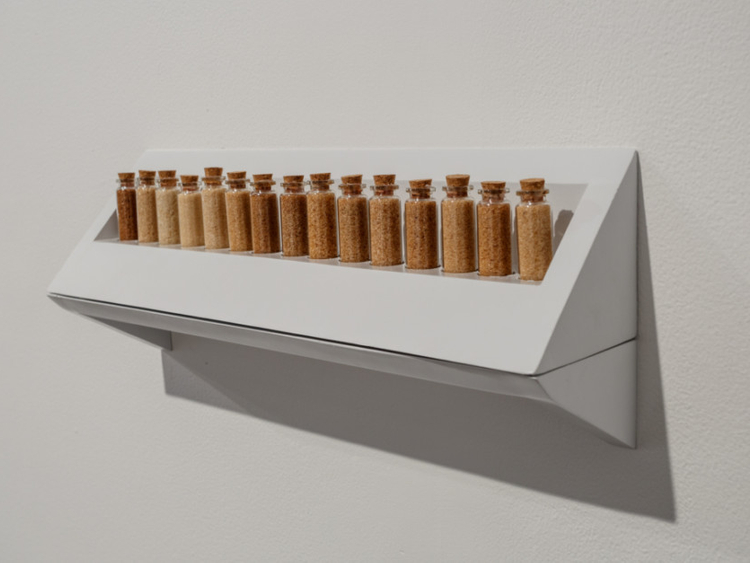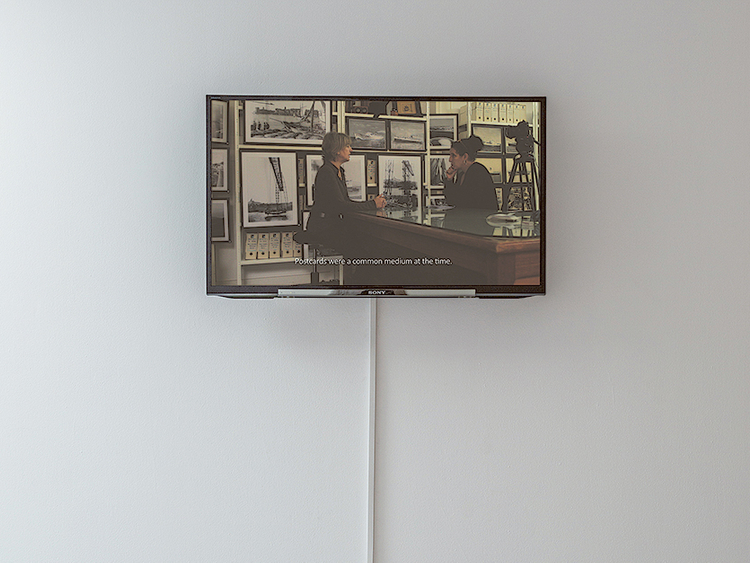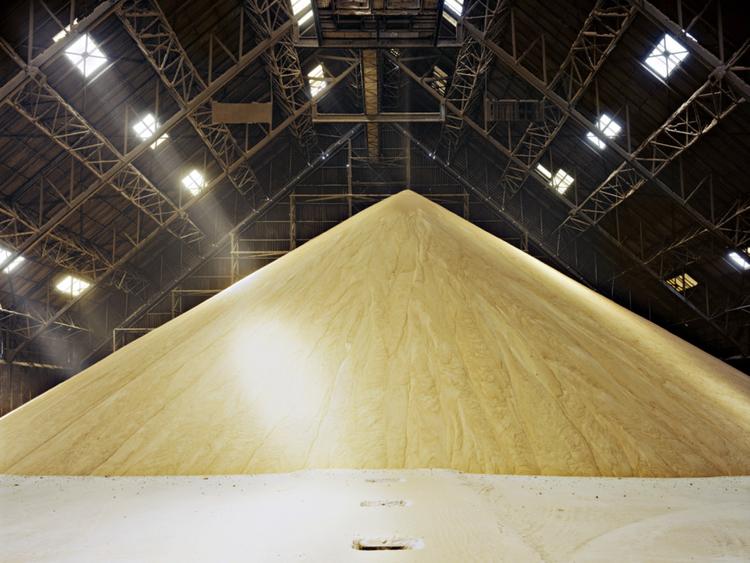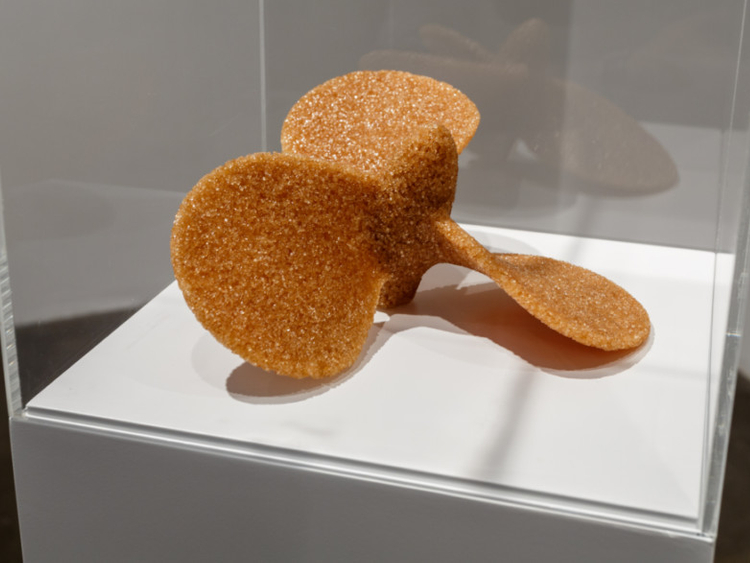
Zineb Sedira’s interest in investigating ideas of mobility, memory and transmission of legacy is inspired by her parents’ migration from Algeria to France, and her own move to London from Paris, where she was born and raised.
Since both these were journeys by sea, maritime elements are recurring motifs in her work. In her first exhibition in Dubai, “Sands of Time”, the artist deals with themes of human displacement and the preservation of cultural memories through metaphorical references to the movement of goods by sea. The artworks comprise photographs, sculptures and a video installation created during a residency in Marseilles, which was focused on the port.
The series of photographs on display, titled “Sugar Routes”, features what look like mountains of sand. But these are actually piles of sugar stored in silos at the port of Marseilles.
“During my residency, I had access to all areas of the port, and what caught my eye was the silo rented by the St Louis Sucre sugar factory. I was surprised to see that the raw sugar arrives on ships from various places, including former French colonies, in loose form; and that the colour of the sugar ranges from off-white to very dark brown. In the silo, the different coloured sugars from different places get mixed together in a pile that looks like a mountain of sand or earth.
“The sugar is then taken to the factory by trucks, where it is cleaned, refined and packaged off as a global commodity. The distinct colour and local identity of the sugar is thus lost along the trade routes. But traces of every load of sugar that has passed through the silo over decades remain deposited on the walls.
“My photographs of the multicoloured sugar mountains, the truck tracks, and the deposits on the walls tell stories about the economic, political and geographic movements around the sugar trade, as well as the movement of people in a globalised world. They speak about migration, slavery, territories and boundaries, loss of identity, preservation of memories and transmission of legacy. They also evoke the contemporary reality of people desperately attempting to flee by boat from the political and economic turmoil in their own countries,” the artist says.
The idea of movement and staying still is also conveyed through “Sugar Routes II”, featuring sculptures of a propeller and anchor crafted from cane sugar; and “Seafaring”, an installation of a row of bottles filled with different coloured cane sugar.
The three-channel video installation, “Transmettre en abyme”, is a documentation of the late Marcel Baudelaire’s compulsive photographic “ship spotting” of the vessels that arrived and departed from the port of Marseille from 1935 to 1985.
The mountain of photographs in the video highlights the fact that he took over 2,000 pictures of ships. The names of the ships reflect the exotic places they came from and the fact that they carried people of different races and cultures, and cargo that ranged from sugar and logs of wood to live elephants.
The photographs tell stories about colonial history, the endless flow of goods and human cargo transported by the vessels Baudelaire photographed, developments in transportation and handling of cargo, as well as developments in photography itself.
The archive is now looked after by Helene Detaille, whose dedication and passion for preserving this history is evident in the video, where she talks about her research into the life and collection of Baudelaire and the systems used for documenting and conserving it.
“As a photographer and collector of memories, I am interested in the transmission and preservation of my own work. Through this video, I wanted to draw attention to the contribution of little known photographers in preserving the maritime history and cultural memories of Marseille; and to pay tribute to dedicated ‘image keepers’ and archivists such as Detaille, who are preserving this legacy for future generations,” Sedira says.
Jyoti Kalsi is an arts enthusiast based in Dubai.
“Sands of Time” will run at The Third Line until May 30. It is the gallery’s last show in this location, before it moves to a new space in Al Serkal Avenue.
Inspired by nature
Australian artist Ashleigh Manley’s latest exhibition in Dubai, “Gardens by Design”, features watercolour and acrylic paintings inspired by the flora and fauna of the Pacific region and the Middle East. The award-winning artist mostly works with watercolour on thick paper. His detailed depictions of Monsteriosa plants, exotic flowers, trees and birds are very realistic, with the sharp, clean lines and the skilful blending of colours making them look like digital drawings.
“I like watercolour because it is a very challenging and expressive medium. I describe my style as hard-edged graphic watercolour. It is done entirely by hand, but my aim is to get a very sharp edge along with softness in blending,” Manley says.
The artist often combines realistic floral motifs with abstract elements to create dramatic compositions. He is also displaying several abstract acrylic paintings and some figurative works based on scenes from daily life in Australia, Istanbul and other places he has visited. This is his fourth exhibition in Dubai, and his love for the city is apparent in the many paintings he has done of the city’s distinctive modern skyline, the bylanes of Old Dubai, the dhows on the creek, the desert landscape, camels and Arabian horses, and the people on the streets.
“I love coming to Dubai, and I am fortunate that Mövenpick Hotel & Apartments facilitates my trips and exhibitions here. I paint ordinary things that I see around me, because I believe that the role of an artist is to get people to look again at familiar sights in a new and fresh way,” Manley says.
“Gardens by Design” will run at Mövenpick Hotel & Apartments Bur Dubai until May 24.
















